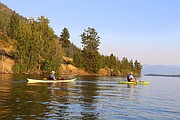New to 7B? Get a kayak for your SUV
Years ago, newcomers to Bonner County wanting to blend in with the locals were advised to drive an old pickup truck with a rifle rack in the back window and a dog in the passenger seat. Now days I offer the following advice to anyone who has recently thrown away out-of-state license plates: Strap a kayak on top of your SUV. The vessel never needs to wet its keel as it looks so 7B-ish just flitting around town.
For those lacking a SUV, stuffing a kayak in the back of a pickup will suffice. So far, I’ve counted as many as six kayaks lashed onto a short-bed truck. Use a little ingenuity and a lot of bungie cords to beat this record.
Since kayaks come in so many sizes, shapes, colors and prices, it pays to do a little research before purchasing the centerpiece for your car top.
Color is your first consideration as the spectrum ranges from flame oranges and yellows to subtle aquamarine hues, often blended together in psychedelic patterns. Don’t discount the camo option for the floating duck blind look. Let your personality dictate this important decision as any color scheme will look impressive strapped to the roof rack of the wheeled mothership.
Next, you must decide between sit-on-top or sit-inside models if you intend to launch your new watercraft. An inexpensive sit-on-top kayak may satisfy your needs for nearshore paddles on a placid lake or a leisurely float down the lower Pack River. They offer easy plop-in/fall-out access, especially for those with creaky joints and less than tightrope-walker balance. You don’t have to worry about your lower body being trapped below decks should the vessel capsize. Most importantly, they usually have sufficient fore and aft deck space for the pup to enjoy the cruise. Outfit Fido with one of those cute canine floatation devices that matches the one you wear.
Please understand the limitations of the inexpensive, recreational kayaks versus those designed for white-water or open-water adventures. Without going into the technical specs, the biggest difference amounts to several hundred dollars on the price tag. Construction materials and designs of specialized boats intended to bounce off of river boulders or ride white-capped waves are more expensive for good reasons. Never attempt to over-paddle your equipment or experience level.
My background as a former aquatics director at scout and church camps compels me to stress watercraft safety before launching your kayak adventure.
Be very careful of the strong winds that can whip up unexpectedly, especially on Lake Pend Oreille. Keep an eye out for the rogue wave created by a power boat that can assume tsunami proportions for a small watercraft.
On the big lake, follow the advice drilled into pilots of single-engine airplanes to always look for a suitable emergency landing strip. Unless it’s a bluebird, dead calm day, I never paddle more than a few hundred feet from shore. After all, you need not get more than 30 feet from rock outcroppings, boat docks or other habitat structure to enjoy the best smallmouth bass fishing.
On flowing water, don’t attempt to squeeze through the Moyie River’s Eileen Dam in a sit-on-top kayak! If it requires an internet search for you to know the difference between Class I and Class V Rapids, stick to the lower Pack River in late June.
Getting back to my original point, join your 7B neighbors by strapping a kayak onto the roof of your SUV. The global plastic shortage that resulted in empty wall and rack space where stores displayed their kayak inventory seems to have abated somewhat. Don’t wait, get one (or more) kayaks to dress up your vehicle before it becomes a county ordinance.



